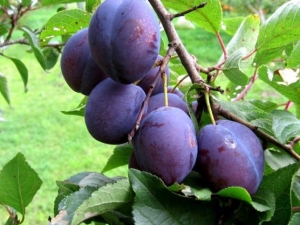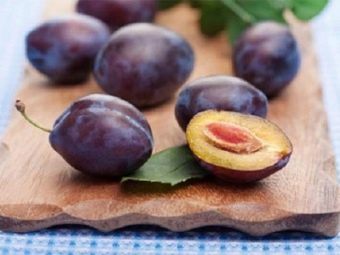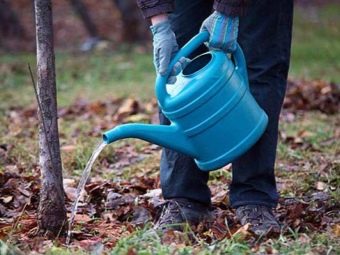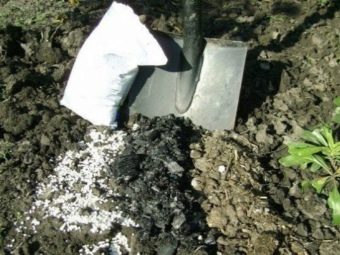Plum "Hungarian": varieties and their features

Plum is one of the most popular garden crops; it decorates the garden and the dining table.However, not every variety is suitable for the Russian climate, so gardeners should choose not only high-yielding, but also frost-resistant varieties. Varieties of the group "Hungarian" just meet both requirements.
A bit of history
Even in ancient times, plum belonged to the most exquisite varieties and was served to the table only at royal feasts and in the homes of nobles. There is a legend that the great conqueror Alexander the Great brought with him from his hikes not only gold and jewels, but also small saplings of the plum tree.
Unfortunately, exact information about the origin of the “Wengerka” has not been preserved, but it is believed that the Caucasus is the birthplace of this culture, it was there that the very first plum trees were obtained as a result of pollination of wild thorns and garden plum. According to another version, plum was first cultivated in Asia, from where it came to the countries of the Old World through Turkey and Persia.
On the European continent, plum was in most cases grown in the Balkans; it was brought to Tsarist Russia at the very beginning of the last century from Hungary. That is why it got its name - "Hungarian."
It is noteworthy that in Hungary itself plum grows literally everywhere - all the old roads and churchyards are seated with this garden crop. By the way, there is another legend, telling that in ancient times the priests handed a spade to repentant sinners in their hands and ordered them to plant and grow a plum to atone for their sins. And since at that time the land belonged to the grandees almost universally and only roads remained public, plums were grown there.
Special features
Trees varietal group "Hungarian" tall, reach a height of 3-5 meters. The krone, as a rule, is round, not thick. Headquarters gray shade, upright with slightly cracked bark.
Young shoots are frequent, have a purple-pink shade without pubescence, may have rarely located spines. Vegetative buds are rather small, their length does not exceed 3 mm, and the shape is cone-shaped.
The leaves are bright green, rounded, slightly pointed upward shape. The average size of the sheet plate is 7.5 x5.5, the structure is loose. The bottom of the sheet has a slight fleecy. The scape of the anthocyanin shade, its length is about 2 cm, and the size of internodes is 3.5 cm.
The yield of the variety is quite high. The first fruiting can be obtained 7-8 years after transplanting the tree to an open place. However, breeders bred several hybrids that can produce a crop after 3-4 years. The life of the trees is 25-35 years. The plant is resistant to frost, in addition, tolerates heat and drought.
Separately, it is necessary to dwell on the peculiarities of the fruit of “Hungary” The berries of this variety are quite large, they reach 6 cm in length, and their diameter is 4.5-5 cm. The shape is usually egg-shaped or elliptical. Fruits are symmetrical, one side slightly flattened, the other, on the contrary, convex, with the side seam clearly pronounced. The color of the berries is dark, almost black, the shade can be blue, mauve or dark purple, the surface is always covered with a slight patina of gray. Less common varieties with bright yellow fruits.
In ripe fruit, the bone is quite easily removed, and the fruit itself is divided into parts without any effort.
The flesh is quite dense and elastic, the dry matter content does not exceed 20%, the sugar content reaches 17%, the degree of acidity - at the level of 0.75%, which makes the berries extremely sweet and unobtrusive tart notes;
"Hungarian" - is the only variety of plums from which prunes are produced - this is the main feature of the group.
To determine the degree of maturity of the fetus is quite simple. Experienced gardeners are advised not to pluck the berries, which are held tightly on the pedicel.Only those plums that remain in the hand after touching the branch fully reveal their taste. However, you can wait for the drain itself to fall to the ground, but in this case it can only be used for cooking compotes, jams and making sweet fillings.
The secret of the popularity of “Hungary” is quite simple - these crops are characterized by high yields, they are able to endure prolonged drought and remain viable in the harsh Russian winters. Their skin is quite dense, so the fruits can tolerate transportation and long storage, in connection with this berry is grown not only in private farms, but also on farms for sale.
Other advantages of the variety include high fecundity - it is quite possible to gather up to 60 kg of fruit from one tree, and the fruit is regular.
However, without the minuses also did not do. The main disadvantage of the culture is its late maturity. As already mentioned, most varieties begin to give fruit after 6 or more years after planting in open ground. Experienced gardeners also mention that culture has a low resistance to such a common disease as moniliosis.
Kinds
"Hungarian" is not a plum variety, but a whole group of plum species that have common characteristics in terms of their external and flavor parameters, and also have approximately the same growing conditions.
"Hungarian Italian" is a variety that has been known since very ancient times. Fruiting begins 4 years after planting in a permanent open place. Adult plants aged 6 years can produce up to 40 kg of berries, and fruiting plants older than 10 years up to 70 kg. There are cases when, on the Black Sea coast, every tree that crossed the 15-year mark gave 150-200 kg of sweet and fragrant fruits. Aging, depending on natural conditions, occurs at the end of summer - the first half of September. Fruits differ in strength, they can withstand quite long storage and transportation without loss of presentation.
Plant height reaches 6 m. The crown of the tree is spreading, the solid trunk is covered with gray bark. Fruits differ in a dark-violet color with the expressed raid of a gray shade. The mass of each reaches 365 g, the flesh is yellow-orange, juicy, fleshy. Sugar content - 12.7%
"Italian Hungarian" is very sensitive to heat, sunlight and humidity. It gives a good harvest only in the southern territories, usually grown in the Kuban and the Crimea. Drought tolerates very poorly, therefore, requires abundant watering.
"Hungarian Moskovskaya", or "Tsaritsynskaya" - a variety that was bred artificially in the 40s of the last century. Since then, it has become one of the most cultivated plums in Moscow and the Moscow region.
Skoroplodnost average. The first fruiting can be expected not earlier than 6 years after planting a young plant in open ground, however, in all subsequent years, the crop is exceptionally stable, rather high. Up to 40 kilograms of fruit can be obtained from each plant. The berries are juicy, they are well tolerated maturation and transportation, do not crack.
The variety withstands frost well. Even if the winter still caused damage to the tree, with the onset of the warm season it can recover pretty quickly. The variety is self-fertile, therefore it does not require additional artificial pollination. The height of the tree reaches 3 m, the crown is spherical, spreading. Leaf plate green tint shoots have a reddish tint.
The shape of the fruit is ovoid, their weight varies from 15 to 30 g. The stone is removed from the fruit without effort. The skin is strong, dense purple tone with a characteristic bluish bloom. The flesh is dark amber color, juicy and fleshy. The taste is tart, sweet and sour.
"Hungarian Belorusskaya" - a hybrid variety.Partially self-fertile, therefore, requires the presence of pollinators - “Croman”, “Bluffrey”, and also “Victoria” or “Pergidron” are best suited.
Refers to early ripening, the first fruiting begins at the age of 3 years. Fruits reach maturity fairly quickly - the crop can be harvested in the last decade of July or early August. Up to 35 kg of fruits can be collected from each plum, this indicator is stable from year to year.
It is characterized by good frost resistance, it recovers very quickly in the case of partial freezing. The plant is medium thick, grows up to 4 meters. Crohn ellipsoid, sprawling, but not very thick.
Fruits have a weight of 40 g, shape slightly elongated. The peel is strong, dark blue with a smoky patina. The taste of berries is sweet with unobtrusive sour notes.
"Pulkovo Hungarian" - this species, which was bred "among the people." His homeland is considered to be the Leningrad region, hence the second name of this plum - from the town of Pulkovo.
As a rule, a variety can be pollinated independently, but greater efficiency can be achieved if we ensure the presence of pollinators; the Hungarian Skorospelka and Moskovskaya varieties are best suited for this. The plant begins to bear fruit in the 4th year of its life in case it is grafted. If the seedling is sprouting, then you can wait for the harvest not earlier than attaining 7-8 years of age. The yield is not so high - from one plant you can get no more than 20 kg, but this indicator is stable in all weather conditions.
The fruits ripen in the month of September, maturity does not occur simultaneously. They are well tolerated by frost, have recoverability, but do not respond well to long rains - prolonged exposure to high humidity leads to the appearance of fruit rot and cracking of berries. Plum is quite demanding to the ground - it responds well to loam, absolutely does not tolerate areas with highly located groundwater. The tree is tall, up to 5 meters in length. The mass of fruits is about 25 g, the flesh is yellow, juicy, the texture of berries is fine-grained. The taste of "an amateur" - quite tart with a pronounced sourness.
It is used for winter preservation in the form of sweet jam, tart stewed fruit and spicy adjika.
"Donetsk" plum - another hybrid, which is characterized by characteristic varietal characteristics.
The period of fruiting begins in the 5th year after planting a one-year-old seedling in open ground. Productivity is quite high - from each you can get 40-50 kg of plums. Maturity is reached at the end of summer - the very beginning of autumn.
The variety is non-sprinkling, so the berries can hang on the branch for quite a long time. Yield index can be greatly increased if you ensure the presence in the immediate vicinity of the “Donetsk Hungarian” and “Kuibyshev”.
It endures drought and prolonged frosts. The tree is tall - from 3 to 5 m in height, the crown is widely pyramidal, the foliage is moderately thin.
The fruits are rounded, each weighs about 30 g, the flesh is amber, and the skin is purple with a slight bluish bloom. The taste is rich, sweet-sour with an unobtrusive tart aftertaste.
"Hungarian Michurinskaya" - a common commercial variety of plums, which is characterized by good keeping quality and transportability.
It is distinguished by high yield with low flaking. Fruits can hang on a branch for up to 30 days, without flaking and without losing their taste properties. It reacts poorly to long frosts, therefore it is recommended for cultivation in the southern and Black Sea regions.
The fruits are oval in shape, each weighing about 30 grams. The flesh is rather fleshy, greenish-yellow, and the peel is purple with a smoky patina. The consistency of the berries is very delicate, they literally "melt in the mouth", the taste is sweet, the sourness is mild.
The varieties "Vengeym", "Korneevskaya", "Voronezh", "Bogatyrskaya", "Dubovskaya", "Home", "Azhanskaya" and "Stanley" are also very popular.
Growing conditions
"Hungarian" is grown in many Russian regions, but each of them has its own zoned species and varieties. The maximum yield can be achieved in warm regions with a mild climate - in the south, the culture is developing quite well in the Moscow region, in the Volga region and in the Central Black Earth regions.
"Hungarian" loves the heat, so special requirements are made to the place of its landing. The site must be well lit, sunny and protected from drafts. Low-lying places for planting are not suitable, because they often stagnate water - it can cause harm to the root system of the plant.
Do not cultivate plums in areas located near the place of flow of groundwater. If such a neighborhood cannot be avoided, one-year-old seedlings should be planted on the slopes or artificially created hills.
Landing
Planted in open ground should be plants that have reached one year old. The pit should be prepared in advance: it should be about 60 cm in diameter and 70 cm in depth. It is best to use for planting the ready soil mixture, which includes a fertile layer of soil mixed with rotted mullein or compost, mixed in a ratio of 1 to 1. You should not use the ground dug from the hole, in this case survival rate and the formation of the root system will be much harder.
To obtain a good harvest, it is worth planting a number of saplings of varieties with approximately the same flowering time - in this case, pollination will be the most complete.
Care
Plum is a fairly easy-to-care variety, but in order for the plant to produce a consistently high yield as long as possible, it is necessary to carry out comprehensive seasonal activities.
So, in spring, care for plum varieties "Hungarian" includes:
- Attraction of birds - for this purpose, birdhouses and feeders should be hung on the branches.
- In March, should be cut off excess shoots and branches.
- In April, you need to make the first dressing. An adult plant requires urea (about 400 g are put under each). Instead, you can feed the tree with calcium nitrate, in this case, 200 g of the drug will suffice.
- It is necessary to protect the plant from spring frosts, for this purpose use a special covering material.
- In May, the second dressing is carried out, it is best to “treat” the tree with infusion of mullein at this time. In addition, during this period it is necessary to remove all basal shoots, as well as sprinkle the near-trunk area with mulch.
- Care in the summertime comes down to regular watering, the introduction of complementary foods and the beginning of the harvest.
- In the fall, they begin to prepare the plant for a cold winter. To do this, it is fed, then shallowly dug up the ground, remove all damaged shoots and branches and at the end of the wound are covered with garden pitch, then the lower part of the trunk is whitened with the thickest branches.
It is believed that the soil under the plum should be moistened at least 0.4 meters. How to ensure this moisture - should be solved empirically based on the available weather conditions. The number of waterings varies from 3 to 5 times per season, while young plants consume less water than adults, at least twice.
In the fall, shortly before the onset of frost, it is necessary to moisten the root zone abundantly - at least 10 buckets of water should be poured out for each plant. In this case, the plant is much easier to endure the winter cold.
However, keep in mind that if the frost came unexpectedly and the soil temperature reached its minimum marks, you should “skip” this stage, otherwise the roots can ic up and rot when spring comes.
Any plant needs fertilizer, and the Hungarian is no exception. For the first two years after transplanting the open ground, the plant suffices those nutrients that were brought into the ground during the formation of the pit under the seedling. Starting from the third year, the supply of nutrients ends and the plant needs new bait.
If the plant gives a consistently high yield, then baits are needed every year, and during the crop failure period, it is better to refuse to apply fertilizer during the season, and next year only to be fed with summer feeds.
The approximate standard is (based on 1 square meter of soil):
- humus - 10-12 kg;
- urea - 20-30 g;
- superphosphate - 60 g (if double superphosphate is taken, the dosage is halved and is, respectively, 30 g);
- potassium sulphate - 20-30 g (it can be replaced with ordinary ash, in this case, it will need 200-250 g).
Urea is usually brought in the spring, and all other compounds are used before the autumn digging.
You should not over-saturate the plant with mineral fertilizers, however, you should not underestimate their role in the development and formation of the crop. With a lack of certain nutrients, the Hungarian starts to hurt, especially if the tree is deficient in nitrogen. potassium or magnesium salts.
If a severe winter is predicted with prolonged frosts, then the plant should be protected. To do this, the near-trunk circle of adult trees is sprinkled with sawdust or pine needles, and young trees should be additionally covered with rags and tied with old canvas bags.
Recommendations
Feedback from summer residents about plums of the Hungarian group of varieties testifies to their exceptionally high yields and good taste characteristics. Moreover, the darker the skin of the fruit, the more nutrients and vitamins are contained in the plums.
"Hungarian" is considered to be the ideal fruit for diet and proper nutrition, since it contains all the necessary vitamins, as well as pectin and glucose, while the caloric content of each berry does not exceed 10 kcal.
Regular use of "Hungarian" contributes to:
- immunity strengthening;
- reduce the harmful effects on the body of free radicals:
- prevention of heart attack, arthritis and asthma;
- lower cholesterol levels;
- normalization of the gastrointestinal tract.
Keep in mind that due to the high sugar content of fruits, it is necessary to limit the consumption of plums "Hungarian" to persons suffering from diabetes and other endocrine diseases, as well as gastritis in the acute stage.
The use of plum is contraindicated for people prone to the formation of kidney stones, since the high content of oxalate in the pulp can stimulate the development of this disease.
And, of course, "Hungarian" is a raw material for prunes, which is so appreciated in the winter season. It is often used to make jam, as well as jam and candy, which will be an excellent alternative to candy.
From the following video you will learn about the benefits of freezing plums varieties "Hungarian".











































